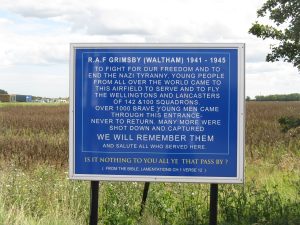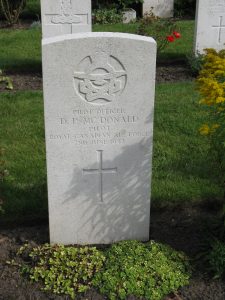I covered the journeys of Patrick’s son-in-law Les Dunn in “More heartbreak for Patrick”. The journeys of Patrick’s son William, known as Bill, have some similarities and almost as many differences.
Bill enlisted on 19th July 1940. His entire time in the RAF was spent in England, apart from one month spent at a Gunnery Training School near Bridgend in Wales. He criss-crossed the country whilst undertaking 18 months of training. Starting from Sussex (where he was born) he saw the counties of Lancashire, Cambridgeshire, Wiltshire and Worcestershire before his posting to 142 Squadron in Lincolnshire. He may have covered 1000 miles in that time. He was on his squadron for six months, and completed six missions in that time. The training for Les took 28 months, but he covered 16,000 miles. Travel time was significant: he crossed both the Pacific and Atlantic Oceans. He also had lengthy periods receiving hospital treatment. Les was on active service for one month, but completed 16 missions in that short time.
 Bill was posted to RAF Waltham. It was renamed RAF Grimsby in September 1943 to avoid confusion with RAF White Waltham, which is near Maidenhead in Berkshire. As with many former wartime airfields the outline of the runways can still be seen from aerial photographs. Lacking their original purpose, most of the buildings have been allowed to decay. There is a commemorative sign at the entrance to the site.
Bill was posted to RAF Waltham. It was renamed RAF Grimsby in September 1943 to avoid confusion with RAF White Waltham, which is near Maidenhead in Berkshire. As with many former wartime airfields the outline of the runways can still be seen from aerial photographs. Lacking their original purpose, most of the buildings have been allowed to decay. There is a commemorative sign at the entrance to the site.
Waltham Railway Station was close by. The line that served it closed in 1980. As with the runways, the track can still be traced from the air. Bill would have been able to travel back to Brighton (about 250 miles to the south) if he had sufficient leave. The trip would have been time consuming as war material took priority over passenger trains. On at least one occasion he was accompanied by a fellow crew member, as my father, who was waiting to join the Royal Navy, remembered. The captain of the crew was Pilot Officer Donald McDonald. He was serving with the Royal Canadian Air Force (RCAF), but was an American. He was born in Thebes, Illinois, a very small village on the banks of the Mississippi, about 50 miles south of St. Louis. In 1940, Donald was working in Seattle, Washington State. At the age of 24, he crossed the border into Canada to enlist.
Most of the 1000+ men who did not return to Waltham/Grimsby have graves across parts of mainland Europe. Some will have no known graves and are commemorated on the Runnymede memorial. A small number are buried in the cemetery at Scartho Road, Grimsby. The Commonwealth War Graves Commission section is, as one has come to expect, immaculately maintained. The families of servicemen, and servicewomen, who died on active service in the UK were given a choice. Either burial with full military honours close to the scene, or the coffin would be returned to their home where the family would take responsibility. There was no option for service personnel from overseas.  Donald McDonald and Robert Cox (also RCAF) are buried at Scartho Road. (Picture) Patrick purchased a burial plot in Brighton.
Donald McDonald and Robert Cox (also RCAF) are buried at Scartho Road. (Picture) Patrick purchased a burial plot in Brighton.
Patrick failed to return any paperwork to the authorities. This is why Bill’s name appears on the Runnymede Memorial (Panel 289). Without information to the contrary, an administrator would have concluded that there was no known grave.
Footnote: Les left New Zealand on 29th May 1942. Bill’s aircraft took off on its last, ill-fated mission the following day. The nature of the war in the air changed significantly in the following two years.
